Lian Li's PC-A05FN: Alternative Thinking at a $99 Price Point
by Dustin Sklavos on December 7, 2011 10:15 PM EST- Posted in
- Cases/Cooling/PSUs
- mid-tower
- Lian Li
Noise and Thermal Testing, Stock
To look at the Lian Li PC-A05FN at any stage of the assembly, I really had very little idea as to how it was going to perform. There's clearly a focus on improving cooling of the CPU, but they also at least appear to have sacrificed cooling the graphics card in the process. Lian Li also made very few allowances towards cable management, and I didn't have high hopes for the acoustics. Early on at least, I was banking on it providing excellent CPU cooling performance at the expense of the other components.

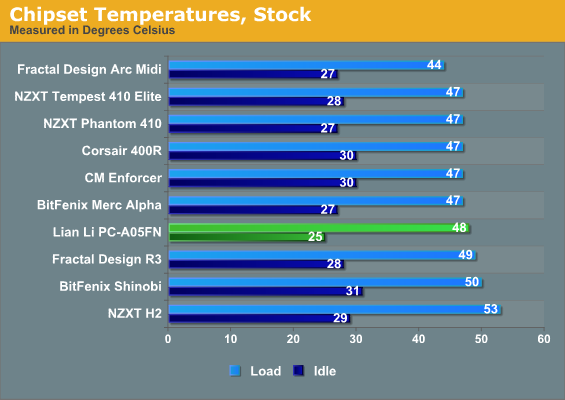
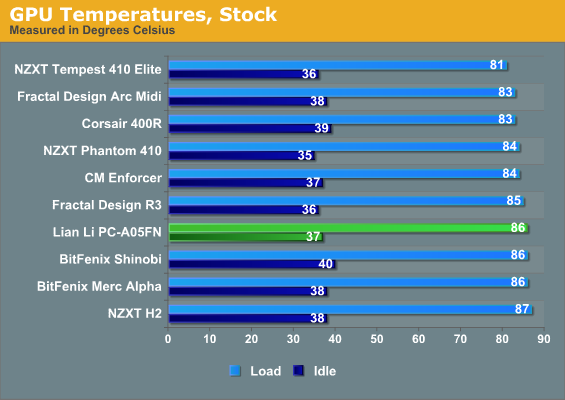
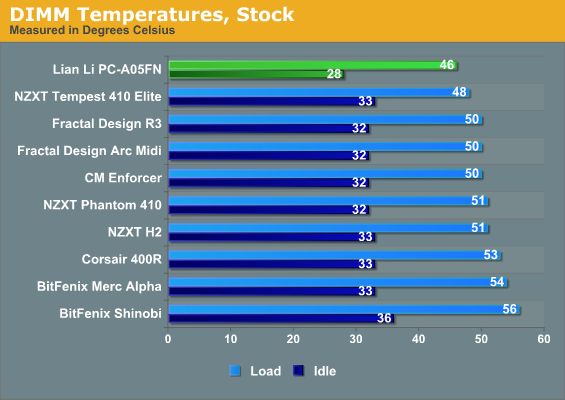
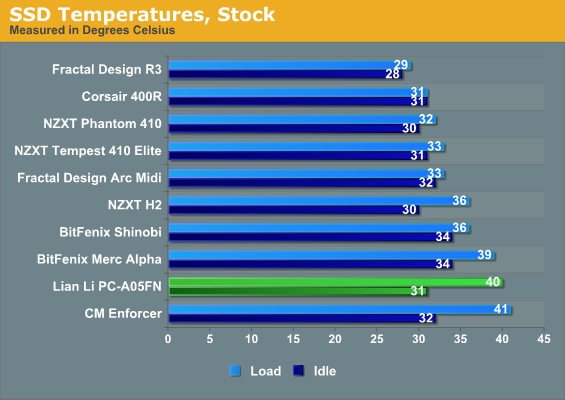
Unfortunately, at least in our stock testing, Lian Li's gamble doesn't seem to have paid off. While idle temperatures are fantastic, once we get to load we find performance to be pretty much on par with everything else. These thermals don't seem to justify the added trouble and care the PC-A05FN requires, but let's see if acoustics are improved.
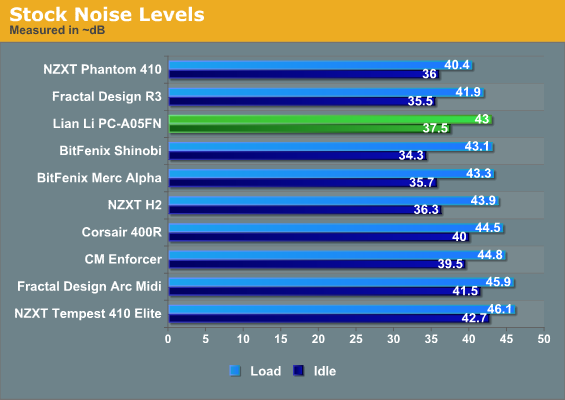
At least the PC-A05FN winds up being reasonably quiet, though under load it kicks up a bit. Maybe our stock settings aren't stressful enough for it? The enclosure seems geared towards CPU cooling and the stock Intel Core i7-875K certainly just doesn't put out much heat under load.










65 Comments
View All Comments
know of fence - Thursday, December 8, 2011 - link
Every case I ever opened had this empty room in the lower front, where only tumble weeds of dusts are blowing, maybe you'll find a dropped drive screw there, or a stray cable. Sometimes you'll even spot a speaker (beeper) from the old days...It's the most logical and consequential thing to stick a power supply there, even if you have to reroute the power cable.
Beenthere - Thursday, December 8, 2011 - link
PSUs are intentionally mounted in the upper back of a case as that's where the heat is that the PSU fan evacuates. Basic engineering 101.Luumpy - Thursday, December 8, 2011 - link
Ya thats the worst possible place for a psu(Top of case) . It sucks in hot air from the rest of pc. Just dumb.Your clearly NOT an engineer.
Most high end cases put psu at bottom of case, where its cool.
Death666Angel - Thursday, December 8, 2011 - link
Really splitting hairs here. The old ATX design says for the PSU to be in the top/back, because the air flow is from the lower/front, once over all components and then out the back . It was designed in old times when PCs used below 100W. Then came 100W CPUs and 300W graphics cards and things changed a bit.You cannot say that a PSU _must_ be at the top/back. However, you are just as wrong to say that it is a dumb place for it to be because of sucking in hot air. You can put it in the bottom. You can also put it in the top and turn it upside down (TJ08-E).
Mostly, it doesn't matter nowadays as PSUs get ever more efficient, more and more becoming quieter and even semi-passive to the point where their exhaust ability is negligible and their need to be cooled also diminishes. And people with beefy hardware have one or two 120/140mm exhaust fans anyway.
To the original poster: This design didn't really win any space by the positioning of the PSU. Also, a lot of modern designs use that space for HDDs, drives bays, larger fans and other interesting things. Depending on the usage scenario, dead space can be used quite effectively (water cooling, where you need space for a pump and a reservoir for example).
crackedwiseman - Thursday, December 8, 2011 - link
I made a build for a client of mine back in early 2009 using an earlier model of this case - the significant difference was the motherboard tray was "upside down", with the CPU being on the bottom and the GPU being on top. It performed spectacularly; the build was an overclocked i7-920 and a GTX 260, with a pair of 3.5" HDDs.Yes, it's cramped - thats the price of a small case. But (the older models at least) could handle pretty much any high-end single GPU system; this isn't made for gaming rigs, it's made to cram a powerful work machine into as little space as possible, which can be appealing depending on the availability of office space.
johnsmith9875 - Thursday, December 8, 2011 - link
It has a hot spot at the top of the case. I use a slot cooler to take the heat that the video card generates and get it out of the box, otherwise it would cook anything near the top of the case.Because the cover on the front obstructs airflow I keep it off in the summer. In winter it seems to be adequately ventilated.
What it needs is a blowhole in the top.
Chuck_NC - Thursday, December 8, 2011 - link
Interesting to read the reviews. As an engineer, there are some obvious points to make. I doubt that the HDD temps going higher are intentional, but a byproduct of goofing the airflow around the front. With the PSU blowing out, the HDD fan just pulls the hot exhaust right back in again. The PSU and HDD fans end up recirculating the air. They should reverse the direction of the HDD fan to blow out, and provide positive pressure from other fans going *into* the case (side fan, back, etc.). Would drop all temps, especially those in the front of the case. Anyway you do this, the HDDs are going to be warmer though.By moving the PSU from the typical top over the CPU area over to the front bottom, there is much less air being drawn out of the top back of the case, causing a hot spot area. Again, a side intake fan would help that but at the expense of noise and an added fan, which also adds less reliability (fans fail faster than any other PC part).
I would guess that whoever designed this was looking more at aesthetics and less at airflow, but some minor changes fixes the airflow problems. And the blowhole idea is great - but add some air going into the case somewhere else.
Kepe - Thursday, December 8, 2011 - link
You didn't read the article. Air is sucked in by the rear fan, and exhausted by the front fan. Also, the typical place for the PSU has changed from the top back position to the bottom back position over the last, say, five years. I haven't seen cases with the PSU in the top back position for years.Iketh - Thursday, December 8, 2011 - link
Warmer HDD temps are good up to about 45-50C. The problem is HDs running too cool with intakes blowing right on them (below 30C).TwistedKestrel - Thursday, December 8, 2011 - link
I pulled the trigger on this case when there weren't too many reviews out there. I laughed at the picture of the mess of cables - it made me feel better about not being able to figure out a good way to route pretty much everything.I still like it though. The cooling idea may not have paid off, but it hasn't seriously impacted my ability to overclock. The finish is nice, it's reasonably quiet ... better than a fork in the eye. Would I have bought if I'd seen this review first? Probably not!